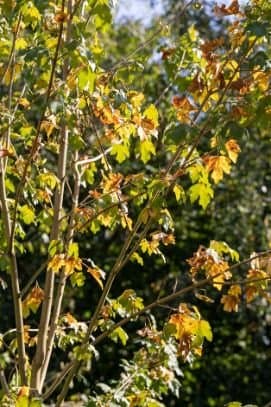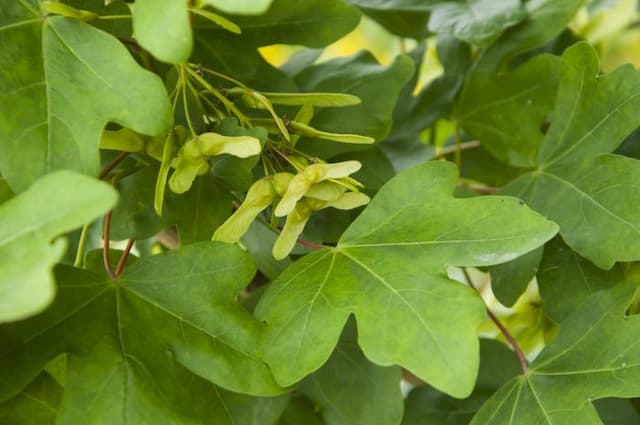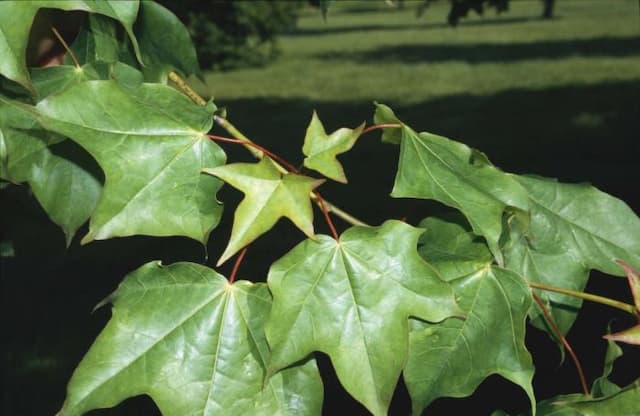Japanese Maple Acer palmatum 'Katsura' (P)

ABOUT
The Japanese Maple 'Katsura' is a stunning ornamental plant, widely loved for its distinctive and vibrant foliage. In spring, the leaves emerge with a striking orange hue that gradually transforms into a fresh and vibrant yellow-green color as they mature. Each leaf is delicately shaped, almost like a hand with outstretched fingers, featuring five to seven pointed lobes that give the plant a soft, yet intricate texture. Come fall, the foliage undergoes another dramatic change, adopting a golden yellow tone that can ignite a garden with color. The leaves have an artistic, lacy quality to them, creating a sense of elegance and visual interest. With its beautiful, changing colors, the plant is a centerpiece in any garden, providing a seasonal display that evolves from the bright freshness of spring to the warm, inviting tones of autumn.
About this plant
 Names
NamesFamily
Sapindaceae
Synonyms
Katsura Japanese Maple, Golden Full Moon Maple, Orangeola Japanese Maple
Common names
Acer palmatum 'Katsura'
 Toxicity
ToxicityTo humans
The Japanese maple is not known to be toxic to humans. There are no widely recognized symptoms of poisoning because it is generally considered non-poisonous. Therefore, ingesting parts of the plant typically does not lead to any adverse health consequences.
To pets
The Japanese maple is also not considered toxic to pets. It is not known to cause poisoning in animals, and ingesting parts of the plant does not typically result in any harmful effects.
 Characteristics
CharacteristicsLife cycle
Perennials
Foliage type
Deciduous
Color of leaves
Varies
Height
15-25 feet [4.5-7.6 meters]
Spread
15-25 feet [4.5-7.6 meters]
Plant type
Tree
Hardiness zones
5-9
Native area
Japan
Benefits
 General Benefits
General Benefits- Ornamental Appeal: Adds aesthetic value with its unique foliage that changes color through the seasons.
- Landscape Versatility: Can be used as a specimen, in borders, or as part of a Japanese garden design.
- Shade Provision: Offers shade in garden spaces due to its broad canopy.
- Wildlife Support: Provides habitat and food for various species of birds and insects.
- Low Maintenance: Requires minimal care once established, making it suitable for gardeners of all skill levels.
- Seasonal Interest: Offers year-round interest with its changing leaf colors and winter silhouette.
- Size Adaptability: A suitable choice for small gardens due to its moderate growth rate and size.
- Soil Tolerance: Adapts well to a range of soil types, though it prefers slightly acidic, well-drained soils.
 Medical Properties
Medical PropertiesThis plant is not used for medical purposes.
 Air-purifying Qualities
Air-purifying QualitiesThis plant is not specifically known for air purifying qualities.
 Other Uses
Other Uses- Japanese maple 'Katsura' twigs can be used for intricate woodwork or bonsai structures, providing a unique texture and color to small-scale models and sculptures.
- The leaves of the Japanese maple 'Katsura' can be pressed and dried for decorative purposes in scrapbooking or decoupage, adding a natural and artistic touch to crafts.
- Bark from the Japanese maple 'Katsura' can be used in landscaping as a mulch, which can contribute to the aesthetic appeal of garden beds while also providing soil benefits.
- The wood of the Japanese maple 'Katsura' is sometimes used in the creation of musical instruments, particularly flutes and small woodwind instruments, for its fine grain and workability.
- During the autumn, its colorful foliage can be gathered and used in seasonal displays or as natural confetti for outdoor events, festivals, or weddings.
- Japanese maple 'Katsura' can be incorporated into fashion design, where its leaves are used to imprint patterns on fabric through a technique called eco-printing.
- The tree can be used in photography as a prop or backdrop due to its vibrant colors and attractive form, enhancing the visual appeal of photoshoots.
- Japanese maple 'Katsura' can be used in educational settings for botany and horticulture lessons, demonstrating pruning techniques and plant growth habits.
- Its sap, on occasion, can be used as a natural adhesive in small craft projects or traditional bookbinding practices.
- Leaves and small branches of Japanese maple 'Katsura' can be employed in artistic installations or set design, providing natural elements that evoke certain moods or themes.
Interesting Facts
 Feng Shui
Feng ShuiThe Japanese Maple is not used in Feng Shui practice.
 Zodiac Sign Compitability
Zodiac Sign CompitabilityThe Japanese Maple is not used in astrology practice.
 Plant Symbolism
Plant Symbolism- Beauty and Elegance: The Acer palmatum 'Katsura', commonly known as the Japanese Maple, is often associated with beauty and elegance due to its delicate leaves and striking colors that change with the seasons.
- Peace and Serenity: The Japanese Maple is symbolic of peace and serenity because of its calming presence in gardens, creating a tranquil space for reflection and relaxation.
- Balance and Harmony: Representing balance and harmony, the Japanese Maple's balanced growth and harmonious shape mirror the Japanese aesthetic principles, suggesting a sense of order and natural beauty.
- Endurance and Patience: With its ability to withstand various climates and grow slowly over time, the Japanese Maple symbolizes endurance and patience, standing steadfast through changing conditions.
- Graceful Transition: The changing foliage from vibrant green to brilliant reds, oranges, and yellows in the fall reflects a graceful transition, symbolic of embracing change and the impermanent nature of life.
 Water
WaterJapanese Maple 'Katsura' requires consistent watering, especially during dry periods. It should be watered deeply once a week, providing about 1 to 1.5 inches of water each time. It's best to water the plant in the morning to allow any excess moisture on the foliage to dry during the day. During hot summer weeks, you might need to water twice a week, especially if the soil dries out quickly. In the winter, reduce watering slightly, as the tree will be dormant and require less water. Make sure the soil around the tree is well-draining to avoid waterlogging.
 Light
LightJapanese Maple 'Katsura' thrives in partial shade to full sun. However, in regions with particularly hot summers, it's beneficial to provide afternoon shade to prevent leaf scorch. An ideal spot would offer morning sunlight and afternoon protection, which can be found on the east or northwest side of a building or under the dappled light of taller trees. This will ensure it receives sufficient light without the stress of midday heat.
 Temperature
TemperatureJapanese Maple 'Katsura' prefers a temperate climate and performs best when the temperature ranges between 60°F and 80°F. It can tolerate minimum winter temperatures down to -10°F to 20°F without significant damage but should be protected from harsh winter winds. The maximum temperature should not exceed 90°F for prolonged periods as this can lead to stress and leaf burn. Providing a mulch layer can help moderate soil temperature and protect the roots.
 Pruning
PruningJapanese Maple 'Katsura' benefits from pruning to maintain its shape, remove any dead or diseased wood, and encourage healthy growth. The best time to prune is during the late winter or early spring before new growth starts. It is generally recommended to prune minimally, only removing what is necessary, to preserve the tree's natural structure. Pruning can also be done in summer to correct any unwanted growth or to thin the canopy, allowing light to penetrate and air to circulate.
 Cleaning
CleaningAs needed
 Soil
SoilThe Japanese Maple 'Katsura' prefers a well-draining, rich soil mix consisting of loamy soil with added peat moss and perlite to improve aeration and drainage. A slightly acidic to neutral soil pH of 5.5 to 7.5 is ideal for optimal growth and health.
 Repotting
RepottingJapanese Maples like 'Katsura' should generally be repotted every 2-3 years, although less frequent repotting may be required as the tree matures due to its slower growth rate.
 Humidity & Misting
Humidity & Misting'Katsura' Japanese Maple thrives in moderate humidity levels but can adapt to the typical outdoor humidity in most temperate climates.
 Suitable locations
Suitable locationsIndoor
Ensure bright light, cooler temp, protect from dry heat.
Outdoor
Partial sun, protect from harsh winds, mulch well.
Hardiness zone
5-9 USDA.
 Life cycle
Life cycleThe Japanese maple 'Katsura' begins its life cycle when the winged seeds, known as samaras, germinate in favorable conditions, typically requiring stratification to break dormancy. After germination, the seedling stage involves root and shoot development, gradually forming the characteristic palmate leaves that display a golden orange hue in spring. As the sapling grows, it undergoes a juvenile phase, where it slowly establishes a branching pattern and starts to exhibit the tree's typical rounded to dome-shaped habit. Transitioning into maturity, the Japanese maple 'Katsura' reaches reproductive maturity and begins to produce flowers in early spring, which are followed by the formation of samaras that mature by fall. Seasonally, the mature tree displays vibrant foliage colors transitioning to bright yellow and then to a fiery orange in autumn before leaf fall. Eventually, when the plant experiences environmental stress or reaches old age, it enters a phase of senescence, leading to reduced vigor and, ultimately, the end of its life cycle.
 Propogation
PropogationPropogation time
Late Winter-Early Spring
Propogation: The Japanese Maple 'Katsura' can be propagated most successfully through grafting, which is the most popular method used for this particular species. This technique usually takes place in late winter before the spring growth starts. In this method, a scion, which is a cutting from a healthy Katsura tree that includes at least one bud, is joined with a rootstock from a compatible species. The cut surfaces of both the scion and the rootstock are matched together and firmly bound with grafting tape, ensuring a tight seal to prevent drying out. The graft should be kept in a moist and warm environment to encourage the tissues to fuse together. After the graft union has taken hold, typically several weeks later, the tape can be carefully removed, and the new tree gradually acclimated to outdoor conditions. Grafting is highly favored for the Japanese Maple 'Katsura' because it ensures the new tree will maintain the specific characteristics of the parent plant, such as its distinct leaf color and shape.







![Freeman maple [Autumn Blaze]](/_next/image?url=https%3A%2F%2Fplants-admin.emdemapps.com%2Fimages%2Fplants%2F%2Fimages%2F604b575b84d87.png&w=640&q=75)

